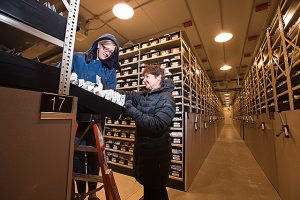6.3 – Proper Storage Protocols

Proper seed storage is crucial to maintain the viability and quality of seeds for future planting. The best methods for storing seeds depend on the type of seeds, but general guidelines exist that are effective on many storage commodities. Click through each to learn more:
Short-term vs. Long-term Storage
Short-term seed storage is for relatively brief periods and focuses on maintaining seed viability for immediate or near-future use, while long-term seed storage is for extended periods and prioritizes the preservation of seeds’ genetic integrity and viability over many years or even centuries. The key differences lie in the duration of storage, the conditions, and the purposes for which the seeds are preserved.
The study of seed longevity is complex, however there are conclusions that can be drawn:
- Seed species, quality and the pre-harvest factors that influence quality are important. Avoid mishandling seeds during conditioning to avoid cracking, bruising and damage.
- Relative humidity and temperature are interdependent. Harrington[1] states that the sum of the percent relative humidity and temperature should not exceed 100 for safe short-term storage.
- For long term storage, seeds should be dried to equilibrium prior to storage and stored at very cold temperatures.
Seed Quality Impacts
Certain qualities of seeds may determine how well and how long a seed species is able to survive in storage. By this we mean how long can a species be stored and remain viable (able to produce a healthy plant) when removed from storage. The same abiotic and genetic factors that impact a seed’s ability to germinate also impact a seed’s longevity in storage.
Short-term and long-term seed storage refer to different methods and conditions used to preserve seeds for varying durations of time. The primary differences between these two types of storage are the duration of storage and the associated storage conditions. Work through this activity to explore the differences and each storage duration’s main goals.
Review
Work through these interactive questions to review the important concepts discussed.

Earn an industry recognized micro-credential at: CSU Upskill.
Seed that is alive; seed that can grow; containing structures and substances including enzyme systems that give it germination potential.
The storage of seeds for a shorter period, typically less than a year, where viability is maintained without the need for strict environmental controls.
The practice of storing seeds for extended periods, often in controlled environments with low humidity and temperature, to preserve seed viability.
Non-living environmental factors that influence living organisms, including light, temperature, water, and soil conditions.
Traits inherited from parent plants that influence seed characteristics such as size, growth rate, disease resistance, and yield potential.
